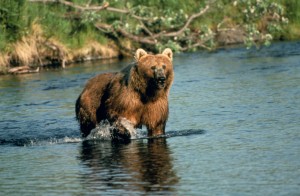We have much more to do and your continued support is needed now more than ever.
Pebble Mine Even More Disastrous Than First Thought

But if the proposed Pebble Mine is built, it could have devastating consequences for this wilderness paradise, according to a newly revised watershed assessment on large-scale mining in Bristol Bay by the Environmental Protection Agency (EPA)—which considered 233,000 public comments, consulted with tribes, and received input from independent scientists and peer reviewers. The report finds that even in a best case scenario—with no leaks or failures—the massive mine would destroy up to 90 miles of salmon streams and up to 4,800 acres of wetlands, and produce acidic and toxic-laden waters.
As a result, local grizzlies, wolves, bald eagles, and other wildlife that consume salmon will all be impacted. So will Alaska Natives, who have relied on subsistence fishing for thousands of years. And so will the commercial fishery, which, according to a new report by researchers at the University of Alaska’s Institute for Social and Economic Research, provides 12,000 jobs and about $500 million annually in direct income to workers across the country.
All of this is at risk from Pebble Mine, the colossal gold and copper mine proposed at the headwaters of Bristol Bay that would generate up to 10 billion tons of toxic mine waste stored in massive earthen dams covering over 10 square miles. Even under the best conditions, it would be virtually impossible to keep the toxic waste from leaking into rivers and streams, putting salmon—which are highly sensitive to the slightest increases in certain metals like copper–at great risk.
And if the dams break, it would be absolutely devastating to the river and wildlife downstream. Just last month, a massive landslide at Bingham Canyon mine in Utah—which registered as a 5.1 magnitude earthquake and engulfed tens of millions of dollars in mining equipment and infrastructure—was a preview of the disaster that could occur if Pebble Mine is built. Incredibly, Pebble Mine would be twice the size of Bingham Canyon mine and located in an active earthquake zone.
The EPA’s review provides more than enough information to know that Pebble Mine would pose enormous, irreversible harm to this critically important watershed, and the wildlife and people that depend on it. Yet, despite these risks and the overwhelming opposition to Pebble Mine, foreign mining corporations are charging full steam ahead.
Now is the time for the Obama administration to act. We only have until May 31st to comment on these new findings and urge the EPA to use its power under the Clean Water Act to stop this disastrous project. If we don’t speak up now, Pebble Mine could devastate this wilderness paradise and the rich community of wildlife that calls it home.
![]()
Help protect salmon and grizzlies from toxic mining waste—send a message to the EPA today.





















